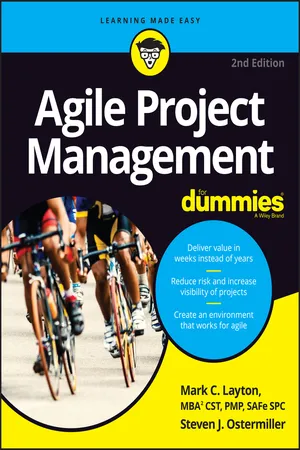Understand why project management needs to modernize due to the flaws and weaknesses in historical approaches to project management.
Find out why agile methods are growing as an alternative to traditional project management, and become acquainted with the foundation of agile project management: the Agile Manifesto and the 12 Agile Principles.
Discover the advantages that your products, projects, teams, customers, and organization can gain from adopting agile project management processes and techniques.
IN THIS CHAPTER
Understanding why project management needs to change Finding out about agile project management Agile project management is a style of project management that focuses on early delivery of business value, continuous improvement of the project’s product and processes, scope flexibility, team input, and delivering well-tested products that reflect customer needs.
In this chapter, you find out why agile processes emerged as an approach to software development project management in the mid-1990s and why agile methodologies have caught the attention of project managers, customers who invest in the development of new software, and executives whose companies fund software development departments. This chapter also explains the advantages of agile methodologies over long-standing approaches to project management.
Project Management Needed a Makeover
A project is a planned program of work that requires a definitive amount of time, effort, and planning to complete. Projects have goals and objectives and often must be completed in some fixed period of time and within a certain budget.
Because you are reading this book, it’s likely that you are either a project manager or someone who initiates projects, works on projects, or is affected by projects in some way.
Agile approaches are a response to the need to modernize project management. To understand how agile approaches are revolutionizing projects, it helps to know a little about the history and purpose of project management and the issues that projects face today.
The origins of modern project management
Projects have been around since ancient times. From the Great Wall of China to the Mayan pyramids at Tikal, from the invention of the printing press to the invention of the Internet, people have accomplished endeavors big and small in projects.
As a formal discipline, project management as we know it has only been around since the middle of the twentieth century. Around the time of World War II, researchers around the world were making major advances in building and programming computers, mostly for the United States military. To complete those projects, they started creating formal project management processes. The first processes were based on step-by-step manufacturing models the United States military used during World War II.
People in the computing field adopted these step-based manufacturing processes because early computer-related projects relied heavily on hardware, with computers that filled up entire rooms. Software, by contrast, was a smaller part of computer projects. In the 1940s and 1950s, computers might have thousands of physical vacuum tubes but fewer than 30 lines of programming code. The 1940s manufacturing process used on these initial computers is the foundation of the project management methodology known as waterfall.
In 1970, a computer scientist named Winston Royce wrote “Managing the Development of Large Software Systems,” an article for the IEEE that described the phases in the waterfall methodology. The term waterfall was coined later, but the phases, even if they are sometimes titled differently, are essentially the same as originally defined by Royce:
- 1. Requirements
- 2. Design
- 3. Development
- 4. Integration
- 5. Testing
- 6. Deployment
On waterfall projects, you move to the next phase only when the prior one is complete — hence, the name waterfall.
Pure waterfall project management — completing each step in full before moving to the next step — is actually a misinterpretation of Royce’s suggestions. Royce identified that this approach was inherently risky and recommended developing and testing within iterations to create products — suggestions that were overlooked by many organizations that adopted the waterfall methodology.
The waterfall methodology was the most common project management approach in software development until it was surpassed by improved approaches based on agile techniques around 2008.
The problem with the status quo
Computer technology has, of course, changed a great deal since the last century. Many people have a computer on their wrist with more power, memory, and capabilities than the largest, most expensive machine that existed when people first started using waterfall methodologies.
At the same time, the people using computers have changed as well. Instead of creating behemoth machines with minimal programs for a few researchers and the military, people create hardware and software for the general public. In many countries, almost everyone uses a computer, directly or indirectly, every day. Software runs our cars, our appliances, our homes; it provides our daily information and daily entertainment. Even young children use computers — a 2-year-old is almost more adept with the iPhone than her parents. The demand for newer, better software products is constant.
Somehow, during all this growth of technology, processes were not left behind. Software developers are still using project management methodologies from the 1950s, and all these approaches were derived from manufacturing processes meant for the hardware-heavy computers of the mid-twentieth century.
Today, traditional projects that do succeed often suffer from one problem: scope bloat, the introduction of unnecessary product features in a project.
Think about the software products you use every day. For example, the word-processing program we’re typing on right now has many features and tools. Even though we write with this program every day, we use only some of the features all the time. We use other elements less frequently. And we have never used quite a few tools — and come to think of it, we don’t know anyone else who has used them, either....



